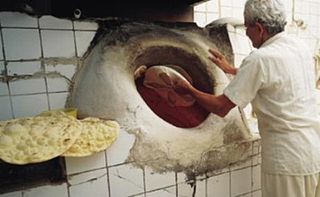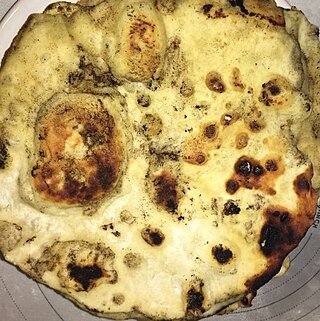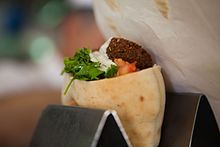
Pita or pitta is a family of yeast-leavened round flatbreads baked from wheat flour, common in the Mediterranean, Levant, and neighboring areas. It includes the widely known version with an interior pocket, also known as Arabic bread. In the United Kingdom, Greek bread is used for pocket versions such as the Greek pita, and are used for barbecues as a souvlaki wrap. The Western name pita may sometimes be used to refer to various other types of flatbreads that have different names in their local languages, such as numerous styles of Arab khubz (bread).

Falafel is a deep-fried ball or patty-shaped fritter of Egyptian origin, featuring in Middle Eastern cuisine, particularly Levantine cuisines, and is made from broad beans, ground chickpeas, or both.

Tahini or tahina is a Levantine condiment made from toasted ground sesame. Its more commonly eaten variety comes from hulled sesame, but unhulled seeds can also be used for preparing it. The latter variety has been described as slightly bitter, but more nutritious. It is served by itself or as a major ingredient in hummus, baba ghanoush, and halva.

A schnitzel is a thin slice of meat. The meat is usually thinned by pounding with a meat tenderizer. Most commonly, the meat is breaded before frying. Breaded schnitzel is popular in many countries and is made using veal, pork, chicken, mutton, beef, or turkey. Schnitzel originates in Austria as wiener schnitzel and is very similar to dishes such as escalope in France and Spain, panado in Portugal, tonkatsu in Japan, cotoletta in Italy, kotlet schabowy in Poland, řízek in Czech Republic, milanesa in Latin America, chuleta valluna in Colombia, chicken chop in Malaysia, and chicken-fried steak and pork tenderloin of the United States.

Levantine cuisine is the traditional cuisine of the Levant, in the sense of the rough area of former Ottoman Syria. The cuisine has similarities with Egyptian cuisine, North African cuisine and Ottoman cuisine. It is particularly known for its meze spreads of hot and cold dishes, most notably among them ful medames, hummus, tabbouleh and baba ghanoush, accompanied by bread.

Sabich or sabih is a sandwich of pita or laffa bread stuffed with fried eggplants, hard boiled eggs, chopped salad, parsley, amba and tahini sauce. It is a staple of Israeli cuisine, as a result of Iraqi Jewish immigration to Israel. Its ingredients are based on a traditional quick breakfast of Iraqi Jews. Sabich is sold in many businesses throughout Israel.

Khubz, alternatively transliterated as khoubz, khobez, khubez, or khubooz, is the usual word for "bread" in Standard Arabic and in many of the vernaculars.

Palestinian cuisine consists of foods from or commonly eaten by Palestinians, whether in Palestine, Israel, Jordan, or refugee camps in nearby countries, or by the Palestinian diaspora. The cuisine is a diffusion of the cultures of civilizations that settled in the region of Palestine, particularly during and after the Islamic era beginning with the Arab Ummayad conquest, then the eventual Persian-influenced Abbasids and ending with the strong influences of Turkish cuisine, resulting from the coming of the Ottoman Turks. It is similar to other Levantine cuisines, including Lebanese, Syrian and Jordanian.

Israeli cuisine primarily comprises dishes brought from the Jewish diaspora, and has more recently been defined by the development of a notable fusion cuisine characterized by the mixing of Jewish cuisine and Arab cuisine. It also blends together the culinary traditions of the various diaspora groups, namely those of Middle Eastern Jews with roots in Southwest Asia and North Africa, Sephardi Jews from Iberia, and Ashkenazi Jews from Central and Eastern Europe.

Haminados, also known as chaminados, or braised eggs, is a traditional Sephardi Jewish dish, popular in Israel, and commonly served as an ingredient or accompaniment to a number of dishes. Haminados are an important element of Israeli cuisine, and are commonly prepared on their own or as part of the Sephardi and Mizrahi Jewish Shabbat stew chamin.

Laffa, also known as lafa or Iraqi pita, is a large, thin flatbread with an Iraqi origin. Laffa is a simple bread that is traditionally vegan and cooked in a tannur (tandoor) or taboon oven. It is most often used to wrap falafel, kebab, and shawarma to make sandwiches, to dip in hummus, matbucha and other dips, or with shakshouka, and other dishes. It is also the traditional bread used in sabich, an Israeli eggplant sandwich.

Middle Eastern cuisine or West Asian cuisine includes a number of cuisines from the Middle East. Common ingredients include olives and olive oil, pitas, honey, sesame seeds, dates, sumac, chickpeas, mint, rice and parsley, and popular dishes include kebabs, dolmas, falafel, baklava, yogurt, doner kebab, shawarma and mulukhiyah.
Gvina levana, which means "white cheese" in Hebrew, also known as Israeli white cheese, is a soft, creamy, and tangy cheese that is popular in Israel. The cheese is made from cow's milk and has a crumbly texture and a slightly sour taste. It is used in a variety of dishes in Israeli cuisine and is an important part of Israeli culture.

Fried cauliflower is a popular dish in many cuisines of the Middle East, South Asia, Europe, and elsewhere. It may start from raw or cooked cauliflower; it may be dipped in batter or breading; it may be fried in oil, butter, or other fats. It can be served on its own, as a mezze or side dish, or in a sandwich. It is often seasoned with salt, spices, and a variety of sauces, in the Middle East often based on tahini or strained yogurt.

Malawach or Melawwaḥ or מלאוואך,, is a flatbread that is traditional in the Yemeni cuisine. It was brought to Israel by Yemenite Jews. Malawach resembles a thick pancake but consists of thin layers of puff pastry brushed with oil or fat and cooked flat in a frying pan. It is traditionally served with hard-boiled eggs, zhug, and a crushed or grated tomato dip. Sometimes it is served with honey.

Arab Indonesian cuisine is characterized by the mixture of Middle Eastern cuisine with local Indonesian-style. Arab Indonesians brought their legacy of Arab cuisine—originally from Hadhramaut, Hejaz, Sudan and Egypt—and modified some of the dishes with the addition of Indonesian ingredients. The Arabs arrived in the Nusantara archipelago to trade and spread Islam. In Java, since the 18th century AD, most of Arab traders settled on the north coast and diffuse with indigenous, thus affecting the local cuisine culture, especially in the use of goat and mutton meat as well as ghee in cooking.

Pilpelchuma, also spelled pilpelshuma, is a chilli-garlic paste similar to a hot sauce originating from the Libyan Jews and commonly used in Israeli cuisine.

Habibi Restaurant is a Lebanese, Middle Eastern, and Syrian restaurant in Portland, Oregon.
























